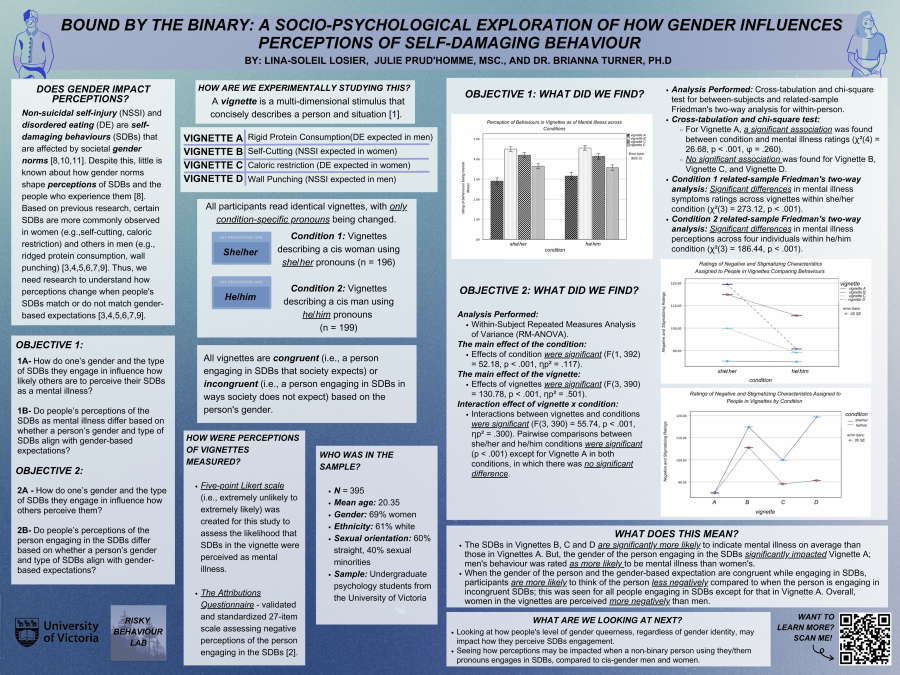Bound by the binary: A socio-psychological exploratory investigation of how gender norms influence perceptions of self-damaging behaviour
An Honours thesis by Lina Losier, co-supervised by Julie Prud’homme, MSc, and Brianna Turner, PhD
Background:
Non-suicidal self-injury (NSSI) and disordered eating (DE) share similar theoretical functions, suggesting that common factors may contribute to these behaviours. This study investigated how binary gender norms
 impact perceptions of people engaging in NSSI and DE in young adults using validated experimental vignettes. The primary research objective was to explore how the gender-stereotyped presentation of self-damaging behaviours (SDB) and the gender of the protagonist (described as either “she/her” or “he/him”) affects negative attitudes and perceptions of mental illness.
impact perceptions of people engaging in NSSI and DE in young adults using validated experimental vignettes. The primary research objective was to explore how the gender-stereotyped presentation of self-damaging behaviours (SDB) and the gender of the protagonist (described as either “she/her” or “he/him”) affects negative attitudes and perceptions of mental illness.
Objective 1a. How do one’s gender and the type of SDB they engage in influence how likely others are to perceive their SDB as a mental illness?
Objective 1b. Do people’s perceptions of the SDB as mental illness differ based on whether a person’s gender and type of SDB align with gender-based expectations?
Objective 2a. How do one’s gender and the type of SDB they engage in influence how others perceive them?
Objective 2b. Do people’s perceptions of the person engaging in the SDB differ based on whether a person’s gender and type of SDB align with gender-based expectations?
Method:
395 University of Victoria students from the SONA system participated in the study. Participants read four vignettes depicting feminized NSSI (self-cutting), masculinized NSSI (wall punching), feminized DE (calorie restriction), and masculinized DE (rigid protein consumption). Participants were randomly assigned to one of two pronoun conditions (she/her vs he/him). The study used the Attribution Questionnaire (AQ-27) to evaluate negative attitudes and a one-item Likert scale to measure participants’ perceptions of mental illness.
Materials
Vignettes used as experimental stimulus (she/her pronouns example):
Vignette A: Charlie does not recall the last day she went without tracking her “macros” (i.e., carbs, proteins, fat). Every meal she eats is protein-rich to maximize muscle growth for weightlifting, and she eats even when she is already full to ensure she hits her macros consistently.
Vignette B: Following a fight with her partner, Taylor goes to the bathroom and cuts herself on her thigh with a razor. Later, when she thinks about the fight, she cuts her forearm with the same razor.
Vignette C: Morgan thinks about food and her body a lot and consistently tracks her calories, weight and how her body looks. She only eats low-fat, low-carb foods, and tries to eat as little as possible. Morgan intentionally stops eating before she feels full to make sure that she is not consuming too many calories.
Vignette D: After finding out that she failed a midterm, Bailey punches her bedroom wall as hard as possible until her knuckles bleed. Later, when she is reminded of her failing grade, she punches the wall again.
Sample of measure used to investigate Research Objective 1:
Do Morgans behaviours suggest she is experiencing mental illness?
- Extremely unlikely
- Somewhat unlikely
- Neither likely nor unlikely
- Somewhat likely
- Extremely likely
Sample of measure used to investigate Research Objective 2:
Thinking about Morgan…do you think or feel….
-
- I would feel aggravated by Morgan and her behaviours.
1 – not at all 9 – very much
-
- I would feel unsafe around Morgan.
1 – not at all 9 – very much
-
- I think Morgan’s behaviours pose a risk to the people around her unless she is hospitalized.
1 – not at all 9 – very much
-
- How likely is it that you would help Morgan with her behaviours?
1- not at all 9 – very much
Results:
Objective 1
- Analysis Performed: Cross-tabulation and chi-square test for between-subjects and related-sample Friedman’s two-way analysis for within-person.
- Cross-tabulation and chi-square test:
- For Vignette A, a significant association was found between condition and mental illness ratings:
-
- (χ²(4) = 26.68, p < .001, φ = .260).
-
- No significant association was found for Vignette B, Vignette C, and Vignette D.
- For Vignette A, a significant association was found between condition and mental illness ratings:
- Condition 1 related-sample Friedman’s two-way analysis:
- Significant differences in mental illness symptoms ratings across vignettes within she/her condition:
-
- (χ²(3) = 273.12, p < .001).
-
- Significant differences in mental illness symptoms ratings across vignettes within she/her condition:
- Condition 2 related-sample Friedman’s two-way analysis:
- Significant differences in mental illness perceptions across four individuals within he/him condition:
-
- (χ²(3) = 186.44, p < .001).
-
- Significant differences in mental illness perceptions across four individuals within he/him condition:
Objective 2
- Analysis Performed: Within-Subject Repeated Measures Analysis of Variance (RM-ANOVA).
Main effect of the condition:
- Effects of condition were significant (F(1, 392) = 52.18, p < .001, ηp² = .117).
Main effect of the vignette:
- Effects of vignettes were significant (F(3, 390) = 130.78, p < .001, ηp² = .501).
Interaction effect of vignette x condition:
- Interactions between vignettes and conditions were significant (F(3, 390) = 55.74, p < .001, ηp² = .300). Pairwise comparisons between she/her and he/him conditions were significant (p < .001) except for Vignette A in both conditions, in which there was no significant difference.
 Significance:
Significance:
The study aims to increase awareness and reduce stigma around SDB while exploring how gender influences the recognition and perception of the severity of SDB.
Research Poster & Results
Presented at the UVic Making Waves Conference

References
[1] Atzmüller, C., & Steiner, P. M. (2010). Experimental vignette studies in survey research methodology. European Journal of Research Methods for the Behaviour and Social Sciences, 6(3), 128-138, 6(3), 128- 38. https://doi.org/10.1027/1614-2241/a000014
[2] Corrigan, P. W., Markowitz, F. E., Watson, A., Rowan, D., & Kubiak, M. A. (2003). An attribution model of public discrimination towards persons with mental illness. Journal of Health and Social Behavior, 44 (2), 162- 179. https://doi.org/10.2307/1519806
[3] Green, J. D., & Jakupcak, M. (2016). Masculinity and men’s self-harm behaviors: Implications for nonsuicidal self-injury disorder. Psychology of Men and Masculinity, 17(2), 147-155. https://doi.org/10.1037/a0039691
[4] Griffiths, S., Murray, S. B., & Touyz, S. (2013). Disordered eating and the muscular ideal. Journal of Eating Disorders, 1(15), 15. https://doi.org/10.1186/2050-2974-1-15
[5] Griffiths, S., Mond, J. M., Murray, S. B., & Touyz, S. (2015). The prevalence and adverse associations of stigmatization in people with eating disorders. International Journal of Eating Disorders, 48(6), 767–774. https://doi.org/10.1002/eat.22353
[6] Kiekens, G., & Claes, L. (2020). Nonsuicidal self-injury and eating disordered behaviours: An update on what we do and do not know. Current Psychiatry Reports, 22(12), 68. https://doi.org/10.1007/s11920-020-01191-y
[7] Lloyd, B., Blazely, A., & Phillips, L. (2018). Stigma towards individuals who self-harm: Impact of gender and Disclosure. Journal of Public Mental Health, 17(4), 184–194. https://doi.org/10.1108/JPMH-02-2018-0016
[8] McGuire, J. K., Beek, T. F., Catalpa, J. M., & Steensma, T. D. (2019). The genderqueer identity (GQI) scale: Measurement and validation of four distinct subscales with trans and LGBQ clinical and community samples in two countries. International Journal of Transgenderism, 20(2––3), 289–304. https://doi.org/10.1080/15532739.2018.1460735
[9] Schoen, E., Brock, R., & Hannon, J. (2019). Gender bias, other specified and unspecified feeding and eating disorders, and college students: A vignette study. Eating Disorders, 27(3), 291–304. https://doi.org/10.1080/10640266.2018.1504536
[10] Turner, B. J., Layden, B. K., Butler, S. M., & Chapman, A. L. (2013). How of ten, or how many ways: Clarifying the relationship between nonsuicidal self-injury and suicide. Archives of Suicide Research, 17(4), 397–415. https://doi.org/10.1080/13811118.2013.802660
[11] Turner, B. J., Yiu, A., Claes, L., Muehlenkamp, J. J., & Chapman, A. L. (2016). Occurrence and co-occurrence of nonsuicidal self-injury and disordered eating in a daily diary study: Which behavior, when? Psychiatry Research, 246, 39- 47. https://doi.org/10.1016/j.psychres.2016.09.012